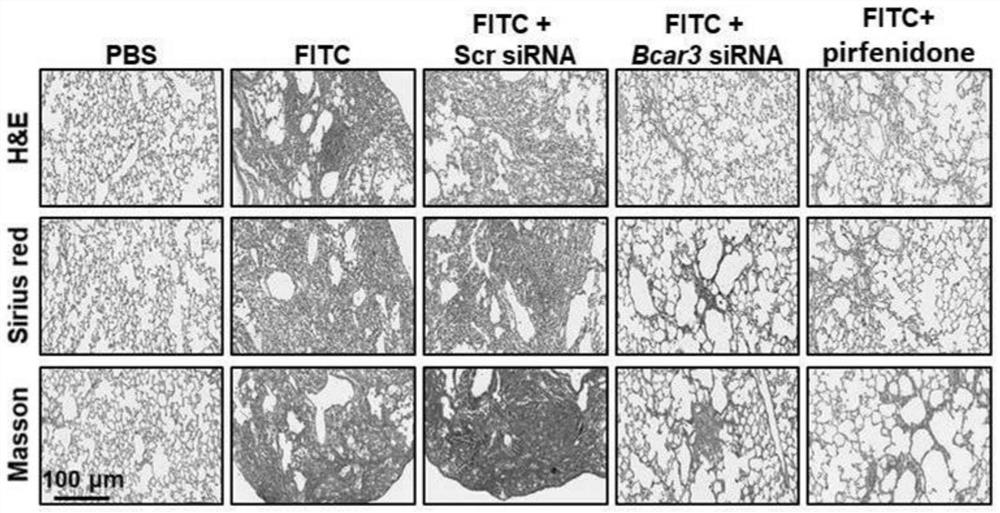BCAR3 inhibitors and their use in prevention and treatment of fibrotic diseases
A fibrotic disease and inhibitor technology, applied in the field of disease prevention and treatment, can solve the problems of high surgical risk, high surgical cost, clinical treatment effect and safety that cannot meet the treatment needs, etc. high effect
- Summary
- Abstract
- Description
- Claims
- Application Information
AI Technical Summary
Problems solved by technology
Method used
Image
Examples
Embodiment 1
[0042] Example 1 The effect of airway injection of BCAR3 siRNA on the degree of pulmonary fibrosis;
[0043] Experimental animals and materials:
[0044] 1. Experimental animals:
[0045] Source: Wild-type mice (WT, C57BL / 6) bred in the animal room of Tongji Medical College;
[0046] Childbearing age: 8 to 10 weeks old;
[0047] 2. Experimental method:
[0048] Wild-type mice were anesthetized by intraperitoneal injection of 1% sodium pentobarbital (70 mg / kg), followed by airway injection of FITC at a final concentration of 0.021 mg / kg, which was purchased from sigma and dissolved in normal saline for use In , mice injected with the same volume of Scr siRNA using the airway were used as controls. On the 14th and 17th days after the administration of FITC, BCAR3siRNA and Scr siRNA were injected into the airway again, and the mice were sacrificed 21 days later to analyze the degree of pulmonary fibrosis in each mouse.
[0049] The severity of interstitial fibrosis was indep...
Embodiment 2
[0054] Example 2 Effects of airway injection of BCAR3 siRNA on fibronectin, type I collagen, α-SMA protein, BCAR3 protein and mRNA levels;
[0055] In order to further evaluate the degree of fibrosis in the lungs of each mouse after FITC injection, the present invention detected fibronectin, type I collagen, α-SMA protein, BCAR3 protein in the lung tissue of each mouse by western blot and RT-PCR respectively. protein and mRNA levels.
[0056] Specifically, the lung tissue of the mice after the experiment in Example 1 was collected, the protein in the tissue was extracted by RIPA lysis solution, and the protein expression levels of target proteins, such as fibronectin, type I collagen, α-SMA and BCAR3, were detected by Western blot. The result is as image 3 shown. For the specific method of the Western blot, please refer to Hu Y et al., 2022, Nature communications, 13:114.
[0057] At the same time, SYBR Premix Ex Taq (TaKaRa) was used for quantitative RT-PCR, and β-actin w...
Embodiment 3
[0061] Example 3 Effect of airway injection of BCAR3 siRNA on hydroxyproline levels;
[0062] 1. Experimental materials:
[0063] Hydroxyproline detection kit: Nanjing Jiancheng Biotechnology Co., Ltd.
[0064] 2. Experimental method:
[0065] The expression levels of hydroxyproline in the lung tissue of each group of mice in Example 1 were determined by using a hydroxyproline detection kit.
[0066] The results are as Figure 5 shown, combined with Figure 5 It can be seen that, as the above-mentioned expression results of Example 2 are consistent, compared with the mice injected with BCAR3 siRNA into the airway, the Scr siRNA mice injected into the airway have more severe fibrosis after induction by FITC, and the hydroxyproline in the lung tissue is more serious. Acid levels were significantly up-regulated.
PUM
 Login to View More
Login to View More Abstract
Description
Claims
Application Information
 Login to View More
Login to View More - R&D Engineer
- R&D Manager
- IP Professional
- Industry Leading Data Capabilities
- Powerful AI technology
- Patent DNA Extraction
Browse by: Latest US Patents, China's latest patents, Technical Efficacy Thesaurus, Application Domain, Technology Topic, Popular Technical Reports.
© 2024 PatSnap. All rights reserved.Legal|Privacy policy|Modern Slavery Act Transparency Statement|Sitemap|About US| Contact US: help@patsnap.com










